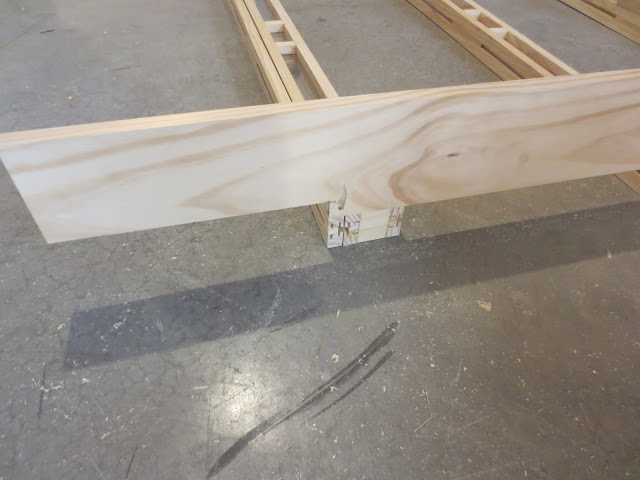I've been a ghost for a few days because work has been keeping me very busy, but I have still been working slowly on the hive.
One of the issues I had to address in this build is a new component which wasn't in my other hive. Since I want to be able to harvest honey from this hive, I need to include a queen excluder. A queen excluder is a piece you put between the main hive body and any frames you want to harvest from. As the name suggests, it acts as a "queen filter" preventing the queen from accessing frames. That means she won't lay eggs in these frames, and the bees respond to this by using the frames exclusively to store honey.
Queen excluders take advantage of the fact that queens are larger than worker bees, so they have small slots which are large enough for workers to move through, but too small for queens to squeeze through. I originally planned to build my own by gluing metal rods in a wooden frame, and had researched the proper spacing required. However, I found that Brushy Mountain Bee Farms sells a plastic excluder, so I decided to buy one and cut it up.
First, I cut and slotted pieces which match up with the length of beelocks. The queen excluder will sit above the upper beelock and below the top two frames. These two frames will be my honey frames.
Just like the beelocks, I added a spacer between the two slotted beams. Unlike the beelocks, this piece will only have one layer - It will contain strips of queen excluder donated from the plastic piece I purchased, and a slot for installing a plexiglass strip to close off the top two cartridges.
I used my oscillating tool with a crescent saw attachment to cut out strips from the donor excluder.
Then I slid the donated strips into the new queen excluder. One row of slots fits inside the beespace.
One queen excluder ready to go!
Now that all pieces of the hive frame are put together, it's time for the assembly. I had been holding off on this part, since it's the greatest risk for failure. I have to get all functional components of the hive mounted, secured, squared, properly aligned, and properly spaced so they accept the cartridges smoothly.
Of course, I have a plan to work from, so luckily I know how the parts need to fit together. Below you can see an overview of how the hive will go together. There will also be cabinet doors on front and rear of the hive.
For this final construction, I've switched from glue construction to pocket holes. I need this frame to be solid, and also I will probably need to unscrew and make modifications to pieces as I go. Luckily my Kregg jig makes pocket holes easy and flawless every time.
Three beelocks mounted to the front cabinet sides, including the beelock with the feeder housing. I'm using cartridges to make sure the beelocks are spaced correctly, and a square to make sure all pieces are aligned with each other.
All beelocks mounted, and beginning the inner joists. These will add strength to the structure and also act as the doorstop for the inside edge of the cabinets. I bought magnetic latches for the cabinet doors which will mount on the interior side of these joists.
All front-side cabinet joists mounted, all cartridge slots tested. Some are a bit too snug, but I'll be solving this with some sanding. Too snug is better then too loose, we don't want bees escaping into the house!
Next up, flip it over and repeat on the backside. Since this side does not have a feeder housing sticking out, it is shallower. You can see how the cartridges will slide in between the front and back cabinet mounts.
The first picture of the hive in its upright position. I'm very relieved to have it standing up, because it means I also get to stand up while I work on it. Crawling around on the floor is not as easy for me as it was when I was a teenager...
For added security and ease of installation/removal, I'm adding guidepieces top and bottom. This keeps the cartridges centered perfectly over the beelocks. There will also be backstops the cartridges will butt up against, but I will not be adding them until I finish the external locks. More on those later.
In this shot you can see the guidepieces in place on most of the slots on the left. The slots on the right have not had their guidepieces installed yet.
As you can see from a sideview with two cartridges in place, the bees would have plenty of room to escape where the cartridge slots fit. Therefore, I've decided to mount external locks around each beelock.
To do this, I'm cutting short pieces of scrap wood left over from building cartridges and beelocks. (I have a lot of this, so it's great to get use out of it!) Then, I used my dado blade to cut two recesses in the piece. It looks very much like a lincoln log at this point...
Next, I drilled three pocket holes on each piece, and mounted it to the cabinet joists. With these pieces in place, I can slide plexiglass strips under the recesses in each piece. This both locks the cartridge in place, and blocks off the slot holes.
That's all for this episode, but since it's Friday I'll have more content soon. I plan to get a lot more work done on the hive over the weekend! Thanks for reading.

















No comments:
Post a Comment